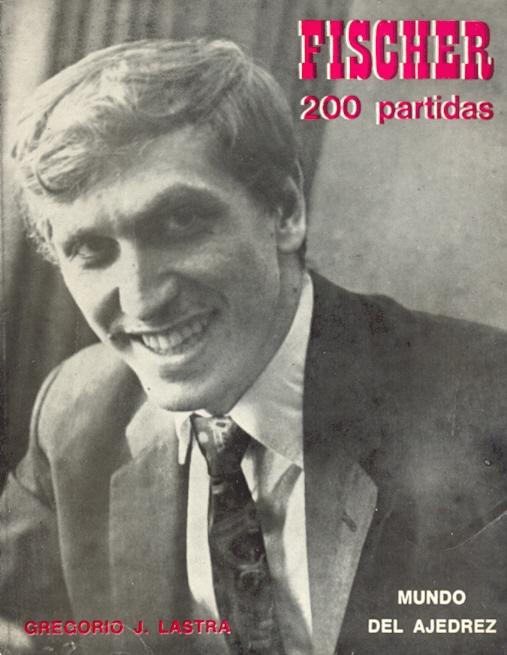
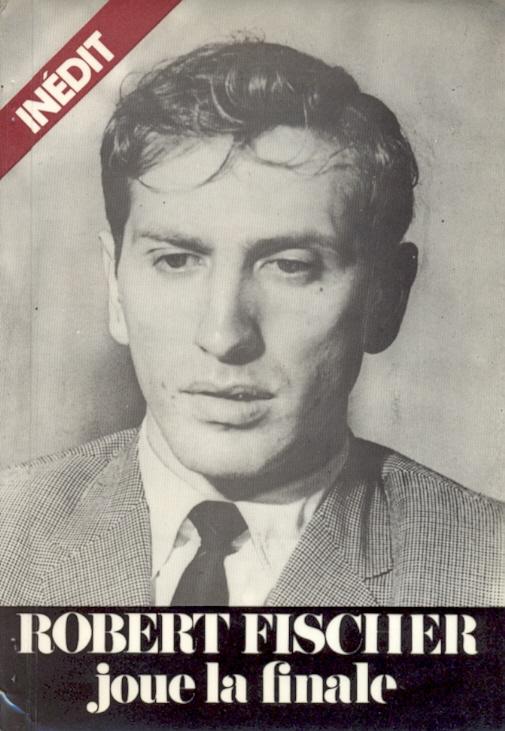
When contacting us by e-mail, correspondents are asked to include their name and full postal address and, when providing information, to quote exact book and magazine sources. The word ‘chess’ needs to appear in the subject-line or in the message itself.
| First column | << previous | Archives [15] | next >> | Current column |
Below we list the books in our collection about, though not by, Fischer and Kasparov. Bibliographical information on any additional titles will be welcomed (as will assistance in acquiring them).


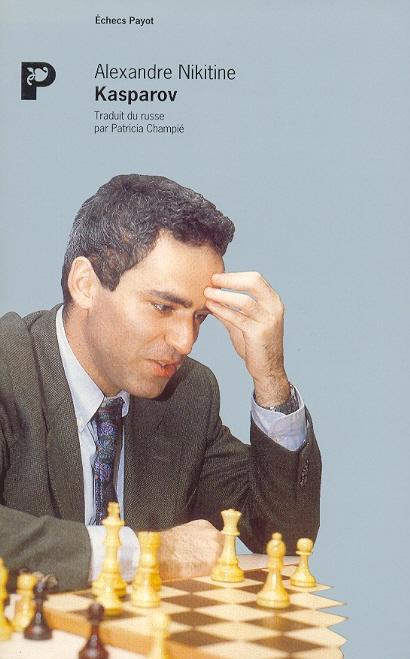
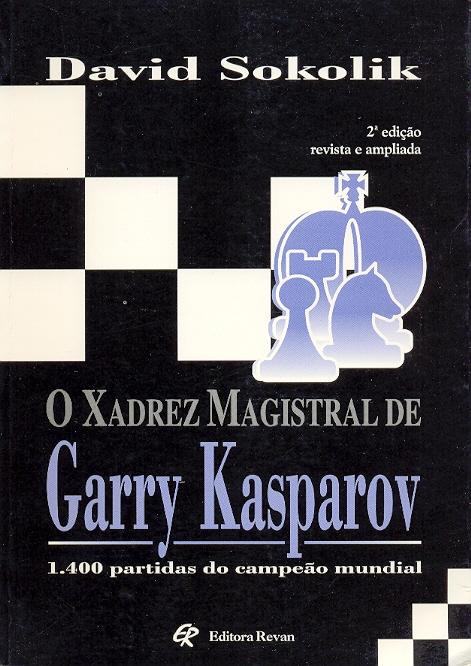
Jean-Luc Grenier (St-Jerome, Quebec, Canada) asks if a photograph is available of the Nice player Pierre Morra (1900-69), whose name is associated with the gambit 1 e4 c5 2 d4 cxd4 3 c3 (or c3 at move four).
We have yet to find one, and nor is it easy to put together a biographical note on him. As regards the gambit itself, the following historical background is quoted, sous toutes réserves, from a theoretical article by Maurice Newman on pages 49-51 of Chess World, April-May-June 1966:
‘Pierre Morra of Nice (not to be confused with other equally well known, or little known, players of the same surname) wrote several articles and a booklet about the opening (c 1950) and gave it his name. Then W. Korn of MCO and J. Wallis of South Africa wrote articles on it. A. Hildebrand of Sweden wrote a booklet on it and Harry Evans of USA (not to be confused with Larry) filled half every issue of The Chess Correspondent from October 1964 to July 1965 with analysis of it. It has been played in important tourneys in the USSR and Fischer has played it without harm to himself against Korchnoi. The Yugoslav grandmaster Matulović became very keen on the Gambit. However, like most gambits, it has become mainly an opening for correspondence players. MCO has completely lost interest (see col. 177 and the umpteenth note to col. 200 in the tenth edition for the only references).’
From Bradley Hodge (Dallas, TX, USA):
‘I am researching materials on “The Philosopher’s Game” or Rithmomachia/Rhythomachy. Is there any evidence of masters from the turn of the nineteenth century to the present having played the game? My most recent reference is to Philidor in 1745. I am also searching for a board and playing pieces.’
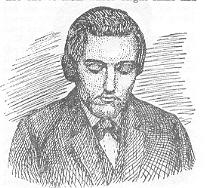
Although this sketch (from Brentano’s Chess Monthly, December 1881, page 369) might be taken to depict Morphy, it was intended to be D.W. Fiske. It seems to be based, not too successfully, on Fiske’s appearance in the New York, 1857 photograph given in C.N. 3828.
A snippet about Fiske is that he was a friend and associate of Mark Twain. Both volumes of Mark Twain’s Autobiography (New York, 1924) contain references to Fiske: pages 214-215 of volume one and pages 341-349 of volume two. On page 344 Mark Twain wrote regarding Fiske:
‘He was as dear and sweet a soul as I have ever known. His was a character which won friends for him, and whoso became his friend remained so, ever afterward.’
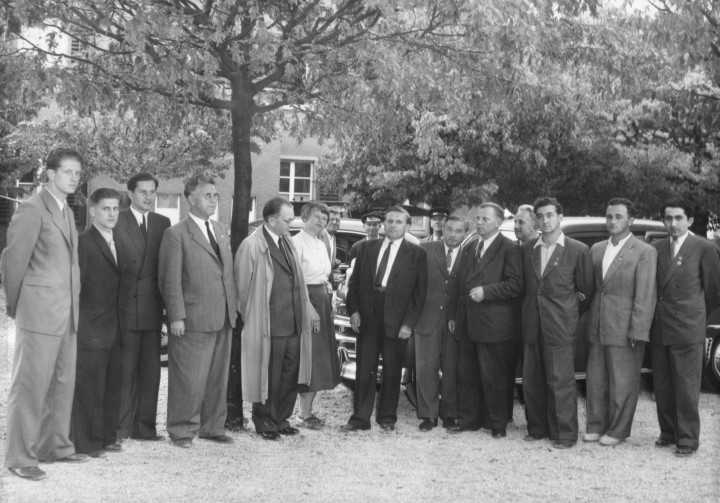
A few readers have had a stab at identifying the above line-up, but a complete caption cannot yet be given. On the far left is Averbakh and, two places along, Keres. On the other side are, from right to left, Petrosian, Geller and Taimanov. Then, after two unidentified figures, comes Kotov.
The photograph was taken during the 1953 Candidates’ tournament in Neuhausen and Zurich; ours is an original print, and we do not know whether it was published at the time. From the plate section of the tournament book Schach-Elite im Kampf (Zurich, 1954) it can be established that the person fifth from the left is Charles Perret, the President of the Organizing Committee, but question marks remain regarding the others.
From page 7 of The Benko Gambit by P. Benko (New York, 1973):
‘It is hardly possible to state precisely who first adopted the gambit. Some Swedish sources mention that it first occurred there in the 1920s and that tournaments especially for the gambit were organized later. The three internationally known masters of Sweden’s past – Ståhlberg, Stoltz and Lundin – also used it, although Ståhlberg found it not to his taste either as White or as Black. Indeed, the Swedish players appear to have used the king’s-side fianchetto, if not the modern order of moves. Of course, the gambit may have occurred elsewhere as well, but it was undoubtedly Lundin who introduced it into international tournament practice. Nevertheless, it later fell into oblivion.
The earliest examples of the gambit in serious competition are the games Bronstein-Lundin [1948], Szabó-Lundin [1948] and Taimanov-Bronstein [1953] ...’
And from page 9 of Benko Counter-Gambit by D. Levy (London, 1978):
‘It is hardly possible to determine exactly when any particular chess opening or variation was played for the very first time, and so it is with the Benko Gambit. It seems most likely that the gambit was born in Sweden during the 1920s and it was the Swedish duo Lundin and Stoltz and the Czech master Opočenský who introduced it in international competition.’
What is known about any such Swedish games from the 1920s?
In passing we add that Levy’s book (page 100) mentions a game ‘Ståhlberg – Stoltz, Sweden, 1933’ which began 1 d4 Nf6 2 c4 c5 3 d5 b5 4 cxb5 Bb7. It may be recalled that Rubinstein v Spielmann, Vienna, 1922 opened 1 d4 Nf6 2 Nf3 c5 3 d5 b5 4 c4 Bb7 and that against Tarrasch in the Pistyan tournament earlier the same year Alekhine played, as Black, 1 d4 Nf6 2 Nf3 e6 3 c4 c5 4 d5 b5 (the Blumenfeld Counter-Gambit). Goldstein v Wilson, Hampstead, 1924 opened 1 d4 Nf6 2 c4 e6 3 Nc3 c5 4 d5 b5 (BCM, December 1924, pages 483-484).
Benko’s book (page 1) notes that ‘the usual starting position of the so-called Benko Gambit’ comes after 1 d4 Nf6 2 c4 c5 3 d5 b5 4 cxb5 a6 5 bxa6 Bxa6. See also pages 233-234 of Pal Benko My Life, Games and Compositions by Benko and Jeremy Silman (Los Angeles, 2003).

Inscription by Benko in his Benko Gambit book
Many writers feel that chess is well served by their mentioning, however vaguely, the enthusiasm for the game (allegedly) shown by celebrities. Such name-dropping may not be founded on published evidence, the meretricious preference being to list as ‘a chessplaying celebrity’ almost any recognizable name which has appeared in the same sentence as the word chess. A chapter entitled ‘They all play(ed) chess’ on pages 251-268 of Chess for Success by Maurice Ashley (New York, 2005) has the longest such list we have seen in a book, featuring everyone and anyone from Adolf Hitler to Enid Blyton. Ashley expresses his ‘special thanks to Bill Wall for his comprehensive list’ and, of course, provides not a scrap of substantiation for any name put forward.
We always welcome solid documentation and citations (in short, facts) about chess-playing celebrities from all fields. What, for instance, is known for sure about connections between chess and any US Presidents and Vice-Presidents?
This group photograph from London, 1927 suggests that William Winter, seated second from the left, was (unless exceptionally long-legged) a small man:
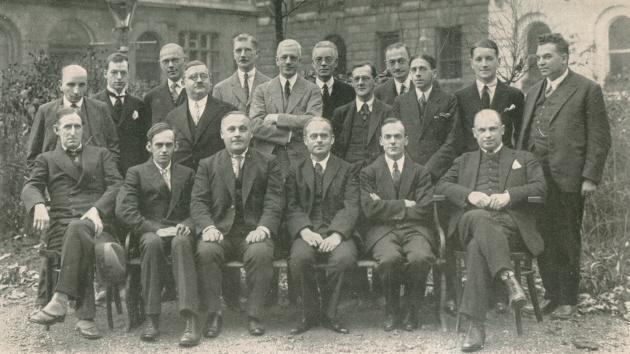
Seated from left to right: F.J.
Marshall, W. Winter, E. Bogoljubow, A. Nimzowitsch, W.A.
Fairhurst, S. Tartakower.
Standing: W.H. Watts, M.E. Goldstein, H. Kmoch, M. Vidmar, R.C.
Griffith, Sir George Thomas, E. Busvine, F.D. Yates, J. Schumer,
E. Colle, V. Buerger, R. Réti
On the other hand, C.N. 2819 reproduced from page 107 of CHESS,
14 November 1935 the following picture:
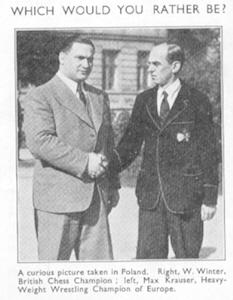
The caption below the photograph reads: ‘A curious picture taken in Poland. Right, W. Winter, British Chess Champion; left, Max Krauser, Heavyweight Wrestling Champion of Europe.’
Moreover, the following shot was published on page 130 of the American Chess Bulletin, September-October 1935, the additional figure being Adolf Seitz:
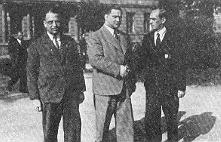
It was taken during a tournament in Łódź, 1935, and William Winter referred to it in his posthumous memoirs (CHESS, 8 March 1963, pages 167-168):
‘Playing conditions were excellent and our accommodation in the Hotel Polonia was luxurious in the extreme. Molly and I had a huge room at the top of the building, one side made up entirely of windows through which nothing was visible save the birds whirling in the heavens. Our fellow guests were an odd company. They included a band of Greco-Roman wrestlers with whose leader, Max Kramer [sic – Krauser], we became very friendly. We went to see him give an exhibition, quite a graceful affair with none of the grunting and heaving which characterizes the all-in version of the sport. A photograph of myself and [Krauser] in the park at Łódź appeared in all the local papers and was reproduced in the magazine CHESS with the caption “Which would you rather be?”’
C.N. 2912 quoted another passage from William Winter’s memoirs, on page 149 of CHESS, 23 February 1963. It concerned Sultan Khan:
‘At the Team Tournament at Hamburg (1930) he also did extremely well on the top board against the best continental opposition though his apparent lack of any intelligible language annoyed some rivals. “What language does your champion speak?”, shouted the Austrian, Kmoch, after his third offer of a draw had been met only with Sultan’s gentle smile. “Chess”, I replied, and so it proved, for in a few moves the Austrian champion had to resign.’
In C.N. 2912 we observed: ‘The problem with this story is that the game between Sultan Khan and Kmoch was drawn.’
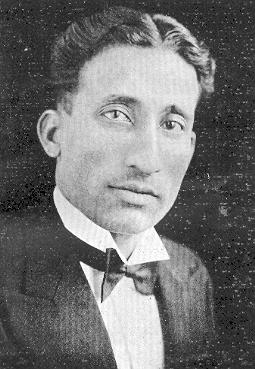
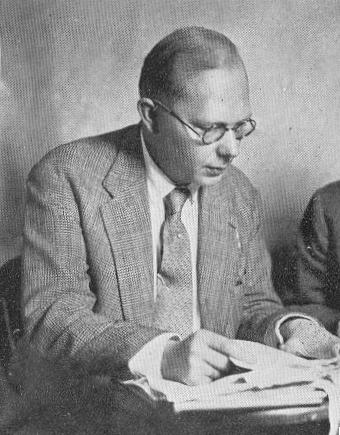
Sultan Khan and Hans Kmoch
Kmoch himself rebutted the anecdote in a letter published on page 245 of CHESS, 25 May 1963:
‘Not that it matters, nor that I would cast any blame on the late Winter, whom I knew as a perfect gentleman. It is only for the sake of curiosity that I ask permission to comment on Winter’s story concerning my game against Sultan Khan.
I never asked Winter or anybody else what language Sultan Khan spoke. Nor did I shout (I never do). Sultan Khan and I had met before. What little conversation there was between us was done in English, of which we both had a command sufficient for the purpose.
Winter, being not asked, had no opportunity to reply “Chess” or anything else.
I did not offer a draw three times, nor did Sultan Khan, who never smiled, meet my offers with a smile. Nor again did I resign a few moves later. And I was not the Austrian champion (contests have not been held at all in my active time).
Sultan Khan had White; we played a Giuoco Piano. After a small number of moves, probably 18 or so, a position was reached which I considered as fully satisfactory for Black.
I offered a draw so as to gain time for my work as a reporter. (I used to be very strict in never offering a draw to anybody unless my position, to the best of my understanding, was fully satisfactory.)
Sultan Khan accepted my offer outright. The game’s ending in a draw is a provable fact.’
We are still trying to find out on what grounds R.N. Coles wrote on page 137 of Dynamic Chess (London, 1956) that Capablanca gave as his reason for practically never playing the Sicilian Defence, ‘Black’s game is full of holes’ (C.N. 2105). The passage is on page 135 of the Dover edition (New York, 1966).
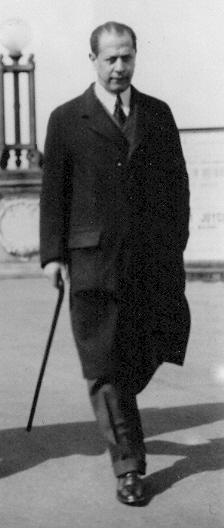
José Raúl Capablanca
Another alleged remark on which more information would be welcomed appeared in a tribute to Capablanca by Reuben Fine on page 3 of The Chess Correspondent, May-June 1942:
‘Capa was a perfect example of the intuitive type of master, who sees that a move is good, but cannot explain why. I recall a story told me by a strong amateur in Mexico, whom Capa once offered to teach. The gentleman was overjoyed and promptly appeared the next day for his lesson. “In the Sicilian Defense”, Capa explained, “after 1 e4 c5 the best move is 2 Ne2.” “Why?” “No importa, it does not matter; it is the best move.” And that was about all that the poor amateur could find out; it was the best move and that was all there was to it. Capa’s judgement was usually right, so this absolute certainty in himself was an invaluable asset.’
Avital Pilpel (Ramat Hasharon, Israel) draws our attention to the Hebrew book Shachmet Le’hana’atcha by Eliyahu Fasher (second edition, Kibutz Kabri, 1980). Pages 168-171 discuss Flohr’s visit to Palestine in May-June 1934 and give, on the basis of reports in the contemporary chess column in Davar (Tel Aviv), three games played by Flohr in simultaneous displays. The first two come from a 76-board exhibition:
Salo Flohr – Ben Haim
Tel Aviv, 31 May 1934
Queen’s Gambit Declined
1 d4 d5 2 c4 c6 3 Nc3 Bf5 4 cxd5 cxd5 5 Qb3 Nc6 6 Qxb7 Nxd4 7 e4 Bxe4 8 Nb5 Nc2+ 9 Kd1 Rc8
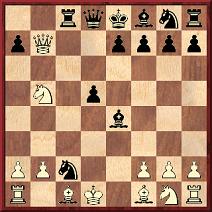
10 Nd6+ exd6 11 Bb5+ Resigns.
Salo Flohr – Wollevleski(?)
Tel Aviv, 31 May 1934
Queen’s Gambit Declined
1 d4 d5 2 c4 e6 3 Nc3 Nf6 4 Bg5 Be7 5 e3 c6 6 Nf3 Nbd7 7 Qc2 a6 8 Rd1 b5 9 c5 Qa5 10 Nd2 e5 11 Be2 Qc7 12 O-O Bd8 13 Bh4 Qb8 14 Bg3 Bc7 15 dxe5 Nxe5 16 Nf3 O-O 17 Nd4 Bd7 18 e4 Neg4 19 exd5 Bxg3 20 hxg3 cxd5 21 Bf3 Qe5 22 Bxg4 Bxg4 23 Rd2 Rfe8 24 b4 Ne4 25 Nxe4 dxe4 26 Re1 Rad8 27 Nc6 Rxd2 28 Qxd2 Qf6 29 Nd4 Qe5 30 Qe3 Bc8 31 Ne2 Bb7 32 Rd1 Qb2 33 Qd2 Qe5 34 Nf4 f5 35 Qd7 Re7
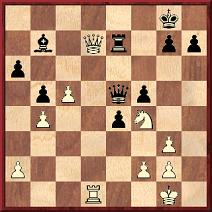
36 c6 Kf7 37 cxb7 Rxd7 38 Rxd7+ Ke8 39 Rxg7 Kf8 40 Rxh7 Kg8
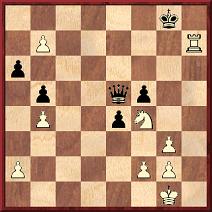
41 Rh8+ Resigns.
The third game, a loss by Flohr, occurred in a display against 11 strong players in which he scored + 9 – 1 = 1 in 4½ hours:
Dubkin – Salo Flohr
Tel Aviv, 2 June 1934
Caro-Kann Defence
1 e4 c6 2 d4 d5 3 Nc3 dxe4 4 Nxe4 Bf5 5 Ng3 Bg6 6 Nf3 Nd7 7 Bd3 e6 8 O-O Ngf6 9 Re1 Qc7 10 Ng5 Bxd3 11 Qxd3 Bd6 12 Bd2 O-O 13 Rad1 Rad8 14 c4 c5 15 d5 exd5 16 cxd5 Nb6 17 Nh5 Nbxd5 18 Bc3 h6 19 Bxf6 hxg5 20 Bxd8 Rxd8 21 Qf5 Nf4 22 Qxg5 Nxh5 23 Qxh5 Bf8 24 g3 a6 25 Qh4 Rxd1 26 Rxd1 Qe5 27 Rd8 g6 28 h3 Kg7 29 Rc8 g5 30 Qg4 Be7 31 Re8 Qd6 32 h4 Qf6 33 h5 Kh6 34 Qc8 Resigns.
The photograph below shows Flohr giving an exhibition in Prague and comes from page 33 of the February-March 1935 Československý Šach:
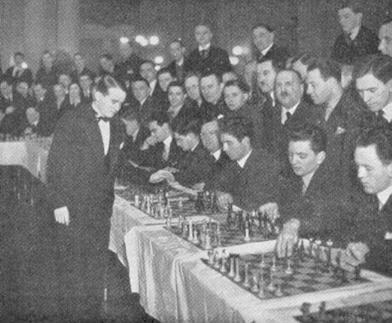
From page 171 of La Stratégie, July 1924:
‘Paris. A l’Hôtel Majestic les 18 et 19 juillet, une petite rencontre, organisée par M. L. Nardus entre les maîtres A. Aurbach et F.D. Yates, reste sans résultat, bien que la dernière présente une position finale quelque peu en faveur du premier nommé.’
This implies that a short match was played, but according to page 369 of the September 1924 BCM there was only one game:
‘At the Hotel Majestic on 18-19 July an exhibition game was played between A. Aurbach and F.D. Yates, the result being a draw.’
What more is known?
C.N. 3950 asked about the correlation between the pieces and figures in this list:
King 9
Queen 5
Rook 8
Bishop 8
Knight 12.
It is the ‘minimum pieces problem’. With nine kings, for example, all the squares of the board can be controlled or occupied. The puzzle was taken from page 171 of Mathematical Recreations & Essays by W.W. Rouse Ball (11th edition, New York, 1939). The book contains an entire chapter on ‘chess-board recreations’, some of which are as complex as any we have seen.
Since the book prize for the last picture quiz (C.N.s 3928 and 3942) was not won, two books are offered to the first reader to identify both persons below.
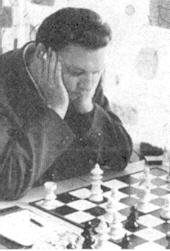
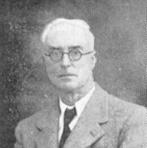
No hints, but a word of encouragement: they are well-known figures in the chess world. Guesses are welcome, and the contest will be left open, if necessary, for a week.
A remark about Bernstein from page 140 of Chess World, 1 August 1946:
‘His chess has perhaps taken a new lease of life since the death of Capablanca, who was the only player that could win brilliancies from Bernstein and nearly always did so.’
Hardly an observation to be taken seriously, of course, and not least because the final game between Bernstein and Capablanca was back in 1914.
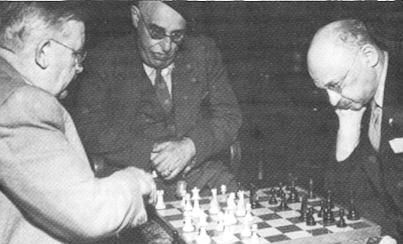
Left to right: M. Vidmar, O. Bernstein and S. Tartakower (Groningen, 1946)
From Calle Erlandsson (Lund, Sweden):
Mr Erlandsson, who provided the above translation, adds:‘In the preface (pages 4-7) to the booklet Volga-gambit by J. Berglund and H. Åkvist (second edition, Stockholm, 1971) there is an historical survey of the opening (1 d4 Nf6 2 c4 c5 3 d5 b5). The following is of particular interest:
“In Sweden the Volga Gambit turned up at the end of the 1920s. According to Fritz Kaijser (Vällingby SS), who over the years has been regarded as the Swedish expert in this area, there was an old teacher of our grandmaster Gösta Stoltz, named Dahlqvist, who started playing the Volga Gambit in Sweden. Not much attention was paid to the variation until [Bruno] Dahlin, a newspaper assistant to the international master Erik Lundin, frequently played the variation during the Stockholm city championship at the end of the 1920s. Whether he, in turn, had obtained the idea from Dahlqvist is not known. Dahlin was not just anybody. His playing strength was so good that he had been Stockholm city champion.
One of Dahlin’s earliest opponents with this opening was Fritz Kaijser himself. Kaijser was curious about the opening and later he introduced it to his colleagues. There were four players who were together and trained at chess: Gideon Ståhlberg, Gösta Stoltz, Stig Lundholm and Kaijser. The training was organized in such a way that thematic tournaments were played. Once there was an idea of making a compilation of the thematic tournaments. Lundholm was the first victim who compiled material on his opening. Kaijser was the next. But harder times came with the Second World War. Chess was not the first priority, so the Volga Gambit, which was Kaijser’s department, was never finished. We therefore never had the chance to see how the ideas developed over the years. According to his own statement, the move 4…a6 did not occur at the outset, but was an improvement by Kaijser.”’
‘Fritz Kaijser was born in Härnösand (northern Sweden) on 13 August 1908 and died in Stockholm on his 75th birthday. He became a Professor of public law in 1964 and was promoted to doctor honoris causa at Stockholm University. He was a reserve at the so-called Olympiad in Munich in 1936 and achieved 6/10 (+4 –2 =4 ). An obituary was published in Tidskrift för Schack, September 1983, pages 232-233.’
We seek nineteenth-century occurrences of the terms ‘world champion’ and ‘world championship’ in the context of tournament play. The examples below come from The Knights and Kings of Chess by G.A. MacDonnell (London, 1894):
Page 7, regarding J.H. Blackburne: ‘But as a tourneyist he is supreme. Multitudinous have been his victories in international contests, and at Berlin, in 1881, he won the championship of the world.’ A footnote after the first sentence reads: ‘Written about three years ago.’
Pages 10-11: ‘In 1881, Blackburne won the first prize at Berlin, together with the Championship of the World.’
Page 31, in the section on G.H. Mackenzie: ‘The above sketch was written in 1887, just after Mackenzie had won the Chess Championship of the World.’
Page 78, on Gunsberg: ‘In all the great contests since then he has taken part and maintained his reputation as a very first-class tourneyist; whilst by his victory at Bradford Place [sic] in 1888, he surpassed all his previous performances and won a place among the champions of the world. Nor have his latest performances been unworthy of his championship, for he drew a long match with Chigorin and made the good score of 4 to 6 against Steinitz.’
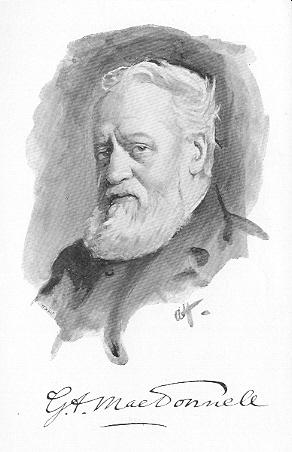
Rev. George Alcock MacDonnell
More will be appearing about MacDonnell in forthcoming C.N. items.
There was a quick winner of the picture quiz: Maurice Carter (Fairborn, OH, USA). The two figures were Karl Robatsch and H.J.R. Murray, and the photographs were taken from, respectively, page 200 of Schach-Echo, 5 July 1960 and page 192 of Chess World, September 1955.
We are grateful to Michael Clapham (Ipswich, England), Claes Løfgren (Randers, Denmark), Michael Syngros (Amarousion, Greece) and Philip Wong (Wilmette, IL, USA) for additions to our lists of books about Fischer and Kasparov. An expanded version of the lists has now been made available as a feature article.
Jerry Spinrad (Nashville, TN, USA) submits the following passage about Abraham Lincoln from page 1 of the New York Times, 15 November 1860 (an article entitled ‘The Next President’):
‘Speaking of custom, reminds me of a curious custom of Mr Lincoln while playing chess – for be it known to the disciples of Caissa, the devotees of Morphy, Paulsen, Anderssen, Staunton, Lichtenhein, and the army of chessplayers, that Lincoln takes delight in the movement on the ordinary, as well as of the political chess-board, and plays a fair game, but not a first rate one. He has a habit of whistling and singing all the time – his musical ability being confined to one tune, and that tune, I sagely suspect, is “Dixie’s Land”. While playing chess, Mr Lincoln seems to be continually thinking of something else. Those who have played with him say he plays as if it were but a mechanical pastime to occupy his hands while his mind is busy with some other subject, just as one often twirls a cane, or plays with a string, or as a pretty coquette toys with her fan.
The way any man plays, either at a game of skill or of chance, is generally a pretty fair index to his character. Success or defeat – the chances – the variations in the probability of triumph – the turning point in the struggle – the exhibition of temper under all circumstances – the stubborn defence in hopeless resistance –the spirited attack with the weaker force, and all the incidents of mimic warfare contribute to develop the strong points of a man’s character. Nor does Lincoln suffer by judgement under this rule. He plays what chessplayers call a “safe game”. Rarely attacking, he is content to let his opponent attack while he concentrates all his energies in the defence – awaiting the opportunity of dashing in at a weak point, or the expenditure of his adversary’s strength, self-reliant in adversity, magnanimous in success, and undaunted by defeat, he is the model of a chess general. His abstractedness, however, must not be regarded as applicable to ordinary pursuits. He seizes a point in conversation with remarkable quickness – often anticipating the meaning before the sentence is concluded.’
A celebrity with a considerable interest in chess is the British writer, actor and presenter Stephen Fry. This photograph appeared in his autobiography Moab is My Washpot (London, 1997) and is reproduced here with his permission.
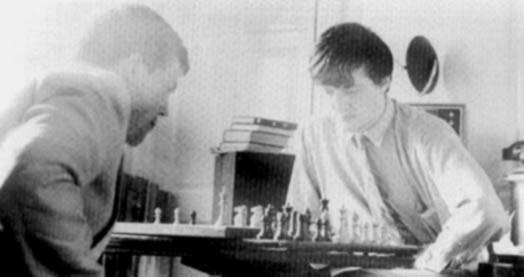
‘Playing chess with Hugh Laurie: my rooms at Cambridge, 1980’
Below is a passage by G.H. Diggle from page 54 of Chess Characters (Geneva, 1984). He refers to himself in the third person as the BM (Badmaster).
‘The BM (as he never fails to inform his opponent whenever he loses a game) “has no time to attend to chess properly – he has other fish to fry (see Rev. G.A. MacDonnell’s masterly treatise [in his 1883 book Chess Life-Pictures] on “Excuses for Losing Games”). And though he rambles through chess literature after a fashion, he seldom condescends to play through a whole game in any depth, but “touches it as an ass mumbles thistles”. His procedure is simple. First of all he skims through all the notes, keeping a sharp lookout for clichés and snarling savagely at the stereotyped idioms of youthful analysts (for as age and infirmities increase the BM fancies himself more and more as the Ayatollah of Annotation). He is, however, on occasion prepared to fish out his pocket chessboard and have a casual look at any brilliancy or, above all, any good blunder, provided that (as Estate Agents say) it is “conveniently situated within one minute’s walk of the nearest diagram”. In fact, in “a given position, where there is something to be done”, the BM has still as good an eye for a combination (provided that he has been already tipped off by the annotator that it is there) as a housewife has for a bargain in a supermarket. In actual play, of course, his difficulty has been that he seldom reaches a position where there is anything to be done.’
‘The strongest of all the chess-playing reverends in Britain in the nineteenth century’ was Harry Golombek’s description of George Alcock MacDonnell on page 188 of The Encyclopedia of Chess (London, 1977). However, on page 231 he called John Owen ‘probably the strongest of all the chess-playing reverends of the nineteenth century’, a contradiction pointed out by W.H. Cozens on page 400 of the September 1978 BCM which Golombek resolved in the 1981 Penguin edition of his Encyclopedia by demoting Owen to ‘one of the strongest of all the chess-playing reverends of the nineteenth century’. Steinitz, for his part, called MacDonnell ‘the shady irreverend fou’ on page 147 of the May 1891 International Chess Magazine.
Golombek’s Encyclopedia, which gave more space to G.A. MacDonnell than to A. McDonnell and G.H. Mackenzie combined, also observed regarding MacDonnell:
‘He was a lively, entertaining but far from accurate writer on chess, and many of the unauthenticated and even groundless anecdotes about the great players of the nineteenth century stem from his inventive pen. He was “Mars” in the Illustrated Sporting and Dramatic News and wrote two entertaining books: Chess Life-Pictures, London, 1883, and The Knights and Kings of Chess, London, 1894.’
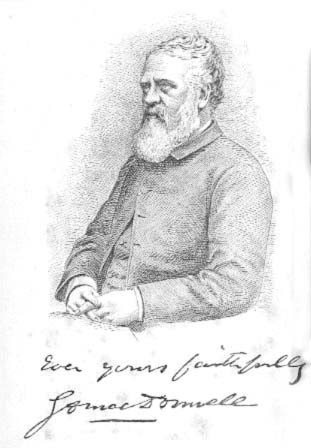
George Alcock MacDonnell
On pages 146-147 of the May 1891 International Chess Magazine Steinitz labelled MacDonnell ‘one of my bitterest and most untruthful persecutors while I was defenseless and powerless to answer’ and stated that MacDonnell ‘has an unconquerable inclination to associate himself with any kind of deception or imposition practiced in the English chess press’.
A notable assertion by MacDonnell was that a negative book review by Steinitz led to the closure of the City of London Chess Magazine. On pages 39-40 of The Knights and Kings of Chess MacDonnell wrote of Steinitz:
‘Years ago he said to me, “Nothing would induce me to take charge of a chess column”; and when I asked why he replied, “Because I should be so fair in dispensing blame as well as praise that I should be sure to give offence and make enemies.” However, when offered a column in the Field, he accepted it, and conducted it for some time with fairness and decorum. His first false move was his attack on Wormald’s book on the openings. When he showed me the proof of his review, I at once condemned its tone, and advised him to omit personalities. But he declined to do so and, the Field rejecting the article, he was fain to publish it in the City of London [Chess] Magazine, where its appearance caused much confusion, and led ultimately to the extinction of that journal. Of the article, suffice it here to say that it filled eight octavo pages, took Steinitz eight months to write, and took his friends eight years to forget.’
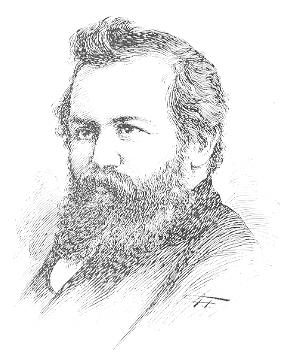
Wilhelm Steinitz
When The Chess Openings by Robert B. Wormald, a 317-page volume, appeared in early 1875 it was warmly welcomed by the reviewers. On pages 44-45 of the March 1875 issue of the City of London Chess Magazine John Wisker wrote that ‘the high praise which has been bestowed upon this work in different quarters seems, on careful examination, to be well deserved’ and he added regarding Wormald:
‘He has executed his task with remarkable accuracy, and has yet limited his pages to the time and memory of every amateur. It is certainly the best book on the openings that exists in English; nor does it appear at all likely that a more convenient or trustworthy guide will be produced just now.’
On page 253 of the Chess Player’s Chronicle, April 1875 William Wayte wrote similarly:
‘We shall not follow our contemporaries in discussing Mr Wormald’s treatment of the openings in detail, but we gladly endorse their opinion that we have here the best book on the chess openings in the English language.’
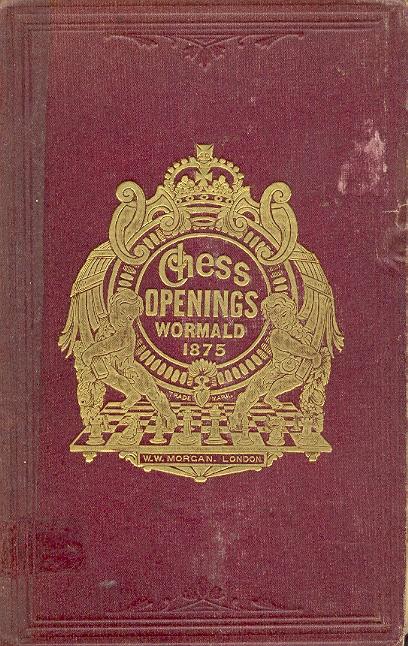
Steinitz’s review of The Chess Openings did not appear in the City of London Chess Magazine until the end of the year, in two parts (November 1875, pages 297-304 and December 1875, pages 331-336). It was thus considerably longer than the eight pages referred to by MacDonnell. Steinitz’s first two and a half pages were an introduction which firstly set out the responsibilities incumbent on chess writers:
‘A chess author is under the obligation of producing in his examinations of each form of play a complete chain of combinations, every link of which is required to be perfect; for if there be the slightest flaw in any of the propositions whereby he supports his conclusions, the whole structure of his analysis tumbles down, like a house made of cards, at the slightest touch. The combined gifts of accuracy, sound originality, correct judgment, and faithful patience – in a word, the chess genius necessary to the fulfilment of such an object – are no common properties, and cannot be accredited to every one who professes to have discovered his own great qualifications for such a purpose by a process similar to the one which enabled the German philosopher to evolve a camel from the depths of his inner consciousness.’
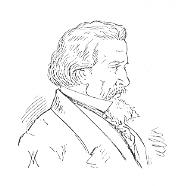
Robert Bownas Wormald
Steinitz then brought in Wormald’s name:
‘Mr Wormald is certainly a problem composer of high merits (of which we shall speak more anon), though we believe he has never succeeded in gaining a prize in any problem competition, and might, therefore, be regarded as scarcely tip-top even in that respect. But, assuming that he ranked highest in the region of chess fiction, it would not give him any title of prominency in the realities of the game, where a multitude of the deepest problems are presented for immediate solution at every stage. No reciprocity has ever been alleged to exist between the qualities requisite for the composition of fine problems and the capacities that command success in the struggles over the board.’
Steinitz commented that ‘we must confess our total ignorance of any achievement on the part of Mr Wormald which would place him on a level even with second-rate players’ and added:
‘Nor have we ever heard of a single good game played by Mr Wormald, against a strong opponent, wherein he might have shown any such marked ability as usually distinguishes the skirmishes of strong masters which appear in the periodical chess publications of the day. So far Mr Wormald has given little indication of his having learned anything before he attempted to teach, and his chess pugnacity seems to have been reserved for the semi-controversial book under our notice, which abounds with attempted exposures of alleged errors that occur in other chess works.’
The next accusation by Steinitz was that Wormald had been too critical of most of the established authorities, with one exception:
‘... we felt, even before investigating the truth of his charges, that some of his long-winded and elaborate demonstrations of the peccadilloes alleged against other writers were doing violence to our toleration. ... Heydebrandt [sic], Jaenisch, Max Lange, Neumann, Suhle – nay, even the combined efforts of Morphy and de Rivière, do not pass the author’s scrutiny unscathed; but we could not find a single instance where he expressly ventured to differ from any recommendations made by the late Mr Staunton in his numerous chess works.’
Nor did Steinitz consider that Wormald had exercised sufficient care ...
‘... on the correction of his proofs, and the expunging of clerical blunders and bewildering misprints, which occur in his book in a larger proportion than in any other existing chess work worthy of the name. This sort of carelessness is in itself quite unpardonable when often recurring; but when we find it also combined with a complete failure of establishing the immense majority of the derogations attempted against contemporaries and previous chess teachers, we are led strongly to suspect that Mr Wormald’s conscience cannot be of a very exact description. ... We have no hesitation in terming Mr Wormald’s Chess Openings a slovenly work, to the contents of which Lessing’s celebrated verdict might be applied, “What is new is not true, and what is true is not new”.’
Steinitz then undertook a detailed spot-check of the book’s analysis. Examples are given below, and we have added in square brackets the relevant opening moves, as well as two diagrams.
‘In the Petroff’s Defence the author gives, in page 14, [1 e4 e5 2 Nf3 Nf6] 3 d4 exd4 best, which the German Handbook justly considers much inferior to 3...Nxe4, on account of the continuation 4 e5 Ne4 5 Qe2 Bb4+ 6 Kd1, etc. On the same page, fifth line from the bottom, a piece of carelessness occurs which would be most vexatious and perplexing to the beginner, who would rack his brains to find any reason for the suggestion in the book, without thinking it possible that the author only committed a simple blunder by recommending [after 1 e4 e5 2 Nf3 Nf6 3 d4 exd4 4 e5 Ne4 5 Bd3] as “better still” 5...Qe7, whereby a piece is left en prise without rhyme or reason.’
‘On page 19, fourth line from the top, we are puzzled to find the author’s meaning when he urges [after 1 e4 e5 2 Nf3 Nc6 3 Bc4 Bc5 4 c3 Nf6 4 d4 exd4 6 e5 d5 7 Bb3] 7...Bb4+ as Black’s best rejoinder. The check is simply impossible, but as a set-off two pieces are left en prise by the move.’
‘Towards the middle of page 25 an addendum is made to a variation which Theorie und Praxis left off without further comment. Had Messrs Neumann and Suhle known how they would be supplemented, perhaps they would have taken a little further trouble; but of course it could not occur to them that any later writer could be so totally devoid of chess instinct as to recommend [after 1 e4 e5 2 Nf3 Nc6 3 Bc4 Bc5 4 O-O Nf6 5 d4 exd4 6 e5 d5 7 exf6 dxc4 8 Re1+ Kf8 9 fxg7+ Kxg7 10 Ne5 Re8 11 Bh6+ Kg8 12 Nxc6 bxc6 13 Rxe8+ Qxe8 14 Nd2 Qe6 15 Qh5 Qf5 16 Qh4 Be6 17 Ne4] 17...Bb6
and then dismiss the position with the short remark, “and White still has some attack, but Black has a pawn more, [and] a strong position”. It requires little experience to see that Black’s best course consists in securing the draw by 17...Be7, with some chance of winning; for in the position where the author leaves his variation White might still continue 18 Nf6+ Kh8 19 g4 Qg6 best 20 Bf4, threatening 21 Be5 with a strong attack.’
‘... It struck us that in common fairness we ought to take a glance into the author’s treatment of the QBP opening, which has been much commended elsewhere. We have to look no further than to Black’s sixth move, in the first main variation in order to discover a state of hopeless confusion in the author’s remarks, at the top of page 42. He there thinks fit to condemn a move which would strike us as the best at first sight – viz. [after 1 e4 e5 2 Nf3 Nc6 3 c3 f5 4 d4 d6 5 dxe5 fxe4 6 Ng5] 6...Nxe5. In support of his view he gives a sub-variation wherein the queen checks backwards and forwards [6...Nxe5 7 Nxe4 d5 “best” (Wormald) 8 Qh5+ Ng6 9 Ng5 Nf6 10 Qe2+ Be7 11 Ne6 Bxe6 12 Qxe6 Qd7], which only seems to help the defence to develop and consolidate all his forces in a manner totally opposed to the spirit of an open game.
On the 11th move he overlooks the decisively superior 11...Qd6, whereupon White dare not take the g-pawn ch, on account of the reply 12...Kf7, followed by 13...Bg4; and he innocently concludes his sub-variation with the observation “and Black has the better game”, though he evidently meant to prove at starting that the indicated line of play should turn out to the disadvantage of the defence. Proceeding, however, with the main variation, containing the alleged better line of defence, we would (at the fifth line from the top) much prefer [after 1 e4 e5 2 Nf3 Nc6 3 c3 f5 4 d4 d6 5 dxe5 fxe4 6 Ng5 d5] 7 Bb5, threatening 8 Qa4, either before or after capturing the knight, according to circumstances, while the author’s 7 e6 is no doubt premature.’
‘... We have reached page 72, where we expected to find a maiden sheet, as the two pages before us only profess to enumerate some of the unimportant variations of the Evans Gambit before the ninth move, which is, after all, the bone of contention between different authorities and players. But we are sadly disappointed. By a singular process of reasoning, the author lets Black play the defence (eighth line from the top) 7...Bb4+ [after 1 e4 e5 2 Nf3 Nc6 3 Bc4 Bc5 4 b4 Bxb4 5 c3 Be7 6 d4 exd4 7 cxd4] instead of the obviously better 7...Nf6 and, having brought about the same position by a transposition of moves as in the defence 5...Bc5 6 d4 exd4 7 cxd4 Bb4+, he afterwards concludes the variation much in White’s favour. Yet a few lines further he refers us for the treatment of the latter defence to Game VII, which we discover at last at page 101. Of course the positions are identical but, to our utter bewilderment, the author this time carries out the variation in favour of Black, and the reader can take his choice between the two versions.’
With respect to the difference between his assessment of The Chess Openings and that other critics, Steinitz wrote:
‘As will have been perceived by chess students, we have as much as possible confined ourselves to errors to which attention had not been directed by other critics, whose competency is above dispute but who nevertheless seem to us to have delivered their judgment in praise of the book with undue haste. ... For our part, we found it impossible to endeavour to do justice at the same time to the public, to the new advents and to old authorities without bestowing the most minute attention before committing ourselves to a final opinion.
In fairness to the other critics who have pronounced views opposite to our own in reference to Mr Wormald’s book, we frankly confess that at first we were much prepossessed in its favour, having been taken in by the remarkable garrulity of the author, which we trusted would be at least supported by common care and ordinary judgment, until on closer research we found the most hollow propositions spread out over pages.’
In the final paragraph of his review Steinitz turned ‘with real pleasure to the last 50 pages of the book, which contain a collection of one hundred of the author’s problems’, which Steinitz praised highly, though not unreservedly.
On pages 292-293 of the November 1875 City of London Chess Magazine the editor, W.N. Potter, wrote regarding Steinitz’s review, ‘we shall be very happy to give Mr Wormald an opportunity of defending his work in our pages’, but no such defence appeared.
As noted above, the review was published in the November and December 1875 issues, and the latter (page 352) announced that the January 1876 number would be the magazine’s last:
‘The reason of its fairly prosperous career being brought to a close is that it has become impossible for us any longer to spare the time which hitherto we have willingly devoted to the service of Caissa.’
The magazine’s death was a lingering one, as page 379 of the January 1876 issue held out the prospect of continuation under a new editor, and one last number did appear. On page 642 of the December 1980 BCM G.H. Diggle affirmed that MacDonnell’s remark about Steinitz’s book review being to blame for the demise of the magazine was ‘not true’. P.W. Sergeant discussed the matter on pages 129-130 of A Century of British Chess (London, 1934), but without giving sources for various key statements.
MacDonnell wrote glowingly about Wormald on pages 45-48 of Chess Life-Pictures (from which our sketch of him above was taken). A further illustration (below), by Sam Loyd, was published on page 1614 of the Scientific American Supplement, 8 December 1877, and Loyd wrote in that column that he had drawn it after meeting Wormald at the Paris Exhibition in 1867.
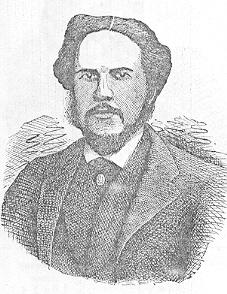
Robert Bownas Wormald
Wormald died in his early forties on 4 December 1876, a year after Steinitz published his review of The Chess Openings. Because it was a densely-packed article which gave only the page references from the book, without the moves leading up to the positions discussed and also without diagrams, it may be wondered whether many readers at the time, or later, looked at the critique closely. If instances can be identified of Steinitz being wrong in his denunciation of Wormald, we should like to be informed.
The reference in C.N. 3974 to G.A. MacDonnell’s pseudonym ‘Mars’ reminds us that on the cover pages of the 3/1933 issue of the Wiener Schachzeitung E. Ramin of Stuttgart reported that with the aid of a 65.5 metre-diameter refractor Professor F. Asching of the Academy of Chess Studies in Timbuktu had established the existence not only of life on Mars but of chess-playing life. The score of the first game between Mars and Earth was given – a quick defeat for the Martians: 1 e4 e5 2 Nf3 Nf6 3 Nxe5 Nxe4 4 Bc4 Bc5 5 Nxf7 Qh4 6 O-O Bxf2+ 7 Kh1 Ng3 mate.
A nineteenth-century celebrity and enthusiastic chessplayer was Heinrich Christian Schumacher (1780-1850), who was described in a feature on pages 97-101 of the Chess Monthly, April 1861 as ‘for many years the first of living astronomers’. The Monthly gave a letter from him to George Walker dated 19 January 1841, as well as the following game:
Heinrich Christian Schumacher – Ludwig Erdmann Bledow
Correspondence, 1840-41
Giuoco Piano
1 e4 e5 2 Nf3 Nc6 3 Bc4 Bc5 4 c3 d6 5 d4 exd4 6 cxd4 Bb6 7 h3 Nf6 8 Nc3 h6 9 O-O O-O 10 a3 Nxe4 11 Nxe4 d5 12 Bxd5 Qxd5 13 Re1 Nxd4 14 Kh1 c6 15 Nc3 Qd8 16 Be3 Nxf3 17 Qxf3 Bxe3 18 Rxe3 Qc7 19 Rae1 Be6 20 Re5 Rad8 21 Qe3 Qb6 22 Qxb6 axb6 23 Na4 Ra8 24 R5e4 Ra6 25 Nc3 Rd8 26 Kh2 b5 27 f4 Raa8 28 Re5 Bc4 29 Ne4 Kf8 30 Nc3 Rd2 31 Ne4 Rxb2 32 Nc5 g6 33 White resigns.
Pages 10-11 of the January 1851 Deutsche Schachzeitung carried an obituary of Schumacher. Additional material on him, based on his chess-related correspondence from the 1840s, appeared in later issues (December 1851, pages 406-410 and February 1852, pages 56-60).
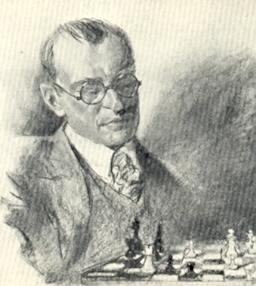
Alexander Alekhine
A quote vaguely ascribed to Alekhine (e.g. on the Internet) is ‘combination is the soul of chess’. Whether he ever made such a remark we cannot say, but certainly he stated (in November 1934, in his Introduction to La Défense du Fianchetto de la Dame by V. Kahn) that the centre is the soul of chess.
Alekhine wrote that Philidor’s observation about pawns being the soul of chess was both right and wrong and that it needed to be understood as meaning ‘Les pions, comme facteur de domination du centre, sont l’âme des échecs’. Philidor, added Alekhine, instinctively realized the importance of the centre but erred in believing that it needed to be dominated by pawns, a pardonable mistake also made by theoreticians (‘including the dogmatic Tarrasch’) for a century and a half. It was not, Alekhine said, until shortly before 1914 that Nimzowitsch, among other young players, began affirming that the centre could be controlled by pieces, even from afar, a paradox at the time but now accepted as true. Kahn’s book, concluded Alekhine, did not refute Philidor’s principle but was most successful in complementing it. (‘Son étude ne réfute pas le principe de Philidor, elle le complète de la plus heureuse façon. C’est le centre qui est l’âme des échecs.’)
A number of C.N. items (the most recent being C.N. 3872) have discussed Fred Reinfeld’s contradictory statements about when he learned chess. Here we give his earliest game known to us, from pages 58-69 of his book How to Play Chess Like a Champion (New York, 1956). The only details supplied about this ‘typical amateur game, conveying above all the lack of consecutiveness which is so common in such games’ were that it occurred in a high-school match when he was aged 15. The punctuation in the game-score is his.
N.N. – Fred Reinfeld
New York, 1925 (?)
Giuoco Piano
1 e4 e5 2 Nf3 Nc6 3 Bc4 Bc5 4 Nc3 Nf6 5 d3 h6 6 O-O d6 7 Nd5 Nxd5 8 Bxd5 Be6 9 Bxe6? fxe6 10 b3? O-O 11 Bb2 Qf6! 12 Qe2 a5 13 c3?! Kh7? 14 Qc2? Qg6! 15 Nh4 Qg5 16 g3 Rf4? 17 Bc1! Raf8 18 Ng2? Rxf2!! 19 Rxf2 Rxf2 20 d4 Rxc2 21 Bxg5 exd4 22 cxd4? Nxd4? 23 Bd8? Nc6+ 24 Kf1 Rf2+ 25 Ke1 Rxg2 26 White resigns.
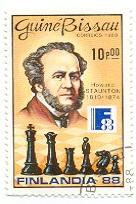
John Townsend (Wokingham, England) asks whether it is known where Howard Staunton was living at the time of the 1841 census.
The three addresses in our Where Did They Live? feature article come from later on:
Here we add that pages 411-414 of the September 1891 BCM reproduced in facsimile form an 1858 letter written by Staunton to Charles Tomlinson. The address was 2 Leigham Avenue, Streatham, Surrey.
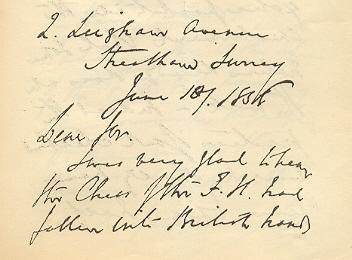
It is worth noting in this context a passage from page 101 of Paul Morphy The Pride and Sorrow of Chess by David Lawson (New York, 1976):
‘Just how soon Morphy met Staunton is not known, but evidently it was on 23 or 24 June [1858] because he enjoyed Staunton’s hospitality at his country home at Streatham that weekend, as Edge mentions in one of his letters.’
Page 226 of David DeLucia’s Chess Library. A Few Old Friends by D. DeLucia (Darien, 2003) shows part of a four-page letter from Staunton to Fitz-Cook in which Staunton’s address was 27 Chilworth Street, Hyde Park, London. The letter is undated but the opening comment (‘With regard to the Chess World Magazine. Although I doubt whether a periodical solely devoted to chess will ever be a very lucrative undertaking ...’) suggests that it was written in the second half of the 1860s, when he was the editor of Chess World.
Thus the earliest address on hand is from 1849, at the time of his marriage, but where did he live during his bachelor days? The year of interest to our correspondent, 1841, was when Staunton began the Chess Player’s Chronicle, and it may be supposed that he wrote many letters. Have any survived?
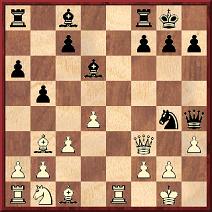
Regarding the famous game Capablanca v Marshall, New York, 1918, page 259 of part one of Garry Kasparov on My Great Predecessors (London, 2003) quotes Capablanca’s note in My Chess Career on 15...Nxf2: ‘The trapper trapped. Black, however, had nothing better, and had to go on with the attack to do or die’. Kasparov’s book then comments:
‘Not reckoning on Shamkovich’s idea 15...h5!? 16 Be3 (16 Nd2 Bh2+ 17 Kf1 Bd6! is equal) 16...Nxe3 17 Rxe3 Qf4 18 Qxf4 Bxf4 19 Re1 Bf5, when Black’s two powerful bishops prevent White from converting his extra pawn.’
In fact, Capablanca’s earlier set of notes (on page 12 of the New York, 1918 tournament book) did ‘reckon on’ the move 15...h5, and he even suggested that it may have been the best move. He wrote of 15...Nxf2:
‘Very likely a mistake and overlooking the reply. 15...h5 was perhaps the best way to keep up the pressure.’
In My Chess Career, however, the Cuban made no mention of 15...h5.
Below, for the record, we give in full his brief notes to the game in the tournament book:
7...O-O: ‘Castling has been supposed to be undesirable at this point, on account of 8 Bd5.
8...d5: ‘The sacrifice, if accepted, yields Black a powerful attack, although of a doubtful nature, and I am inclined to think that White should come out with advantage.’
12 Re1: ‘12 d4 looks like the natural move, but leads to the same thing.’
13 h3: ‘If 13 d4, then will follow 13...Ng4.’
15 d4: ‘The tempting move of 15 Re8 is met by 15...Bb7 16 Rxf8+ Rxf8 17 Qxg4 Re8 18 Kf1 Qe7 19 Be6 Bd5, and Black has the best of it.’
15...Nxf2: ‘Very likely a mistake and overlooking the reply. 15...h5 was perhaps the best way to keep up the pressure.’
18...Bg3: ‘The alternative was 18...Nh1, leading to a complicated game, but always White is apparently able to find a valid defense.’
19 Rxf2: ‘19 Ke1 was also feasible, as it is not possible for Black to play 19...Rae8 on account of 20 Qxf7+.’
22...Rae8+: ‘As it is important for Black to avoid exchanging queens he is now compelled to drive the king to c2 and presently also his rooks are on the wrong side of the board.’
28...Bd6: ‘If, instead, 28...Be3 29 Bxe3 Rxe3 30 Nd2!’
36 Bxf7+: ‘White forces checkmate in six moves.’
Below is the only photograph we recall from the New York, 1918 tournament, which was held at the Manhattan Chess Club. It appeared at the front of the tournament book and on page 252 of the December 1918 American Chess Bulletin. The caption quoted was in both sources.
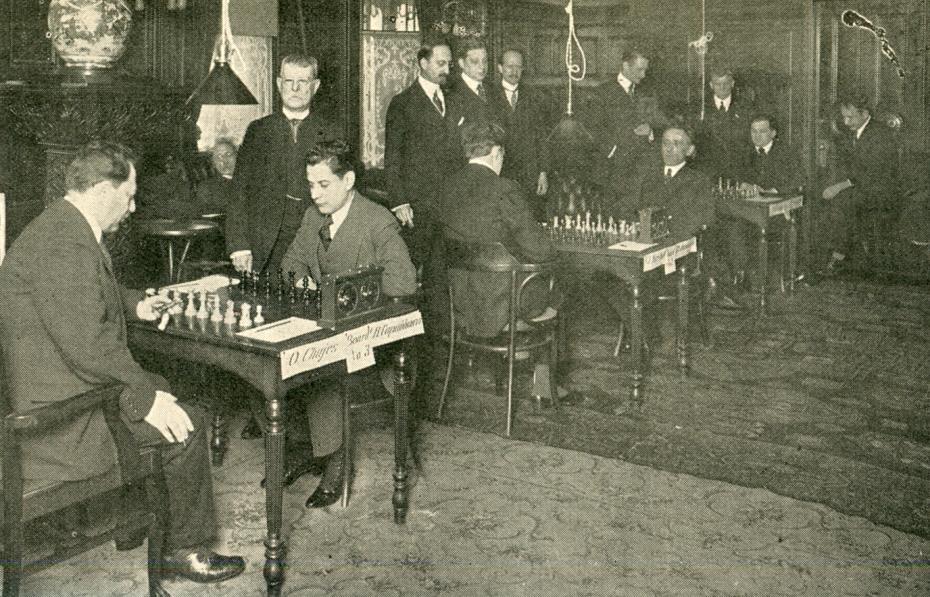
‘Seated, from left to right: O.
Chajes, A. Ettlinger (by window), J.R. Capablanca, F.J.
Marshall, D. Janowsky, J.S. Morrison (obscured), B. Kostić, E.B.
[or B.B.] Edwards
Standing, from left to right: A. Martinez (President), H.R.
Limburg (Vice-President), R. Raubitschek (Treasurer), H. Helms
(Umpire), W. Malowan (Secretary), J. Kraus (Serjeant-at-Arms)’
From an article entitled ‘Glimpses of Alekhine’ by M.E. Goldstein on pages 86-87 of Chess World, 1 May 1946:
‘As con-translator with J. du Mont ... of the French MSS of Alekhine’s book My Best Games of Chess 1908-1923 I naturally met the maestro on a number of occasions. In 1926 we both competed in the Scarborough tournament, and I lost in 40 [sic] moves.
In this tournament Alekhine upbraided me for failing to do more than draw against Sir George Thomas, a game in which I had only a minimal advantage. In fact, even Alekhine’s genius failed to reveal any winning line in the inevitable post mortem.
Alekhine said, “Now I’ll have to beat my old school friend, Victor Khan, or Thomas may come ahead of me.” He did, which was just as well, as Thomas was only half a point behind.
Until well into the small hours of the mornings, Alekhine, Bogoljubow, Colle, Sir George Thomas and myself used to play “Two-Move Chess”. In this fantastic form of the game, a player is permitted to make two moves at a time, provided he does not check on the first move.
Alekhine proved a past-master in this game also; his ability to check on the second move and thus restrict his opponent’s choice was one reason for his superiority over the other players.’
C.N. 3964 mentioned that Alekhine also won a Kriegspiel tournament while in Scarborough.
Goldstein’s account might be taken to imply that his draw against Sir George Thomas occurred at the end of the tournament, but page 303 of the July 1926 BCM states that it was played in the third round of seven. Before the seventh round the leading scores were Alekhine 4½ and Sir George Thomas 4. Both won their final games.
From the same issue of the BCM comes this photograph taken in Scarborough, although not during play in the tournament:
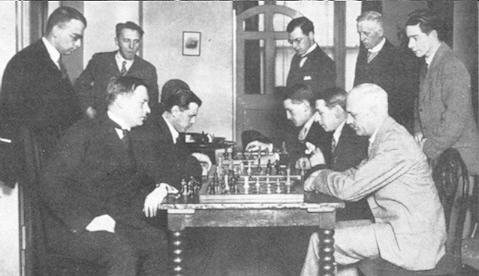
At the board (left to right and
from the front) are A. Alekhine and Sir G.A. Thomas; E.
Znosko-Borovsky and E. Colle; S. Landau and V. Buerger. The
players standing are A. Seitz, V. Kahn, M.E. Goldstein, C.Y.
Dawbarn and G.M. Reid.
Andy Ansel (Laurel Hollow, NY, USA) informs us, on the basis of a notebook of Reinfeld’s, that the game given in C.N. 3978 was played against Stubing in an Inter-Scholastic league match between DeWitt Clinton and Mount Vernon at the Manhattan Chess Club on 15 November 1924. Reinfeld’s book should thus have given his age as 14 rather than 15.
Mr Ansel provides, from the same source, another Reinfeld game,
played at the Manhattan Chess Club three weeks later:
Pimsler – Fred Reinfeld
Morris v DeWitt Clinton match, New York, 6 December 1924
Queen’s Gambit Declined
1 d4 Nf6 2 Nf3 e6 3 c4 d5 4 Bg5 c5 5 e3 Be7 6 Nbd2 Nc6 7 a3 O-O 8 dxc5 Bxc5 9 Rc1 Bd6 10 cxd5 exd5 11 Bd3 Bg4 12 Qc2 h6 13 Bh4 Rc8 14 Bg3 Bxg3 15 hxg3 Ne5
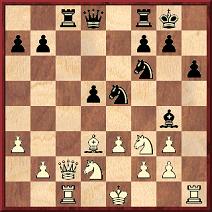
16 Nxe5 Rxc2 17 Rxc2 Qe7 18 Nxg4 Nxg4 19 Nf3 Re8 20 Be2 Qe4 21 Bd1 d4 22 Re2 d3 23 Rd2 Ne5 24 Nxe5 Qxg2 25 Bf3 Qxh1+ 26 Bxh1 Rxe5 27 Rxd3 Rb5 28 Be4 Kf8 29 b4 Ke7 30 Bd5 Rb6 31 f4 Rd6 32 Ke2 b6 33 e4 f6 34 g4 g6 35 Ke3 Rd7 36 e5 Rd8 37 Be4 Rxd3+ 38 Bxd3 g5 39 exf6+ Kxf6 40 f5 Resigns.
Marek Lada (Warsaw) notes that our feature article on chess figures’ addresses has no entry for Anderssen, who is recorded as having lived in Breslau (Wrocław) throughout his life. What details can be found?
On the subject of Anderssen, page 385 of Kings, Commoners and Knaves quoted a remark by Bird in an article on pages 148-155 of the April 1887 BCM that he was the ‘king of all chess players’. Here we add that on page 403 of the December 1916 BCM H.J.R. Murray quoted Steinitz as stating:
‘Anderssen was the greatest master of all times; nor had he his peer as regards brilliancy of style, beauty of conception, and depth of design.’
Where did Steinitz make that remark?
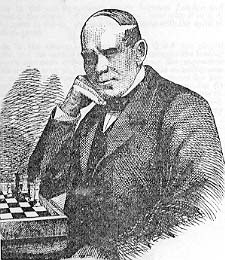
Adolf Anderssen (by Sam Loyd)
On page 207 of the July 1888 International Chess Magazine Steinitz wrote:
‘... I have frequently expressed my doubts whether I was really stronger than Anderssen (the only other player [i.e. apart from Mongrédien] with whom both Morphy and I crossed swords in a match) when I defeated him, it is true, by the small majority of two games only, and I have often thought and still think that probably the German professor who stood no chance against Morphy could at the time have beaten me in a longer match.’
Steinitz won that 1866 contest against Anderssen with a score of +8 –6 =0.
Michael Clapham (Ipswich, England) draws attention to a footnote on page 49 of A Century of British Chess by P.W. Sergeant (London, 1934):
‘Staunton later [i.e. after 1832] had a house at Richmond; but I have not been able to trace when Staunton’s association with the neighbourhood began.’
Our correspondent also mentions that one of the addresses given in C.N. 3979 (2 Leigham Avenue, Streatham) appeared in an 1850s letter from Staunton reproduced on page 110 of Howard Staunton Uncrowned Chess Champion of the World by Bryan M. Knight (Montreal, 1974). The exact year of the letter is not easy to read.
In connection with Knight’s book we add that when, in 1974, Albrecht Buschke sold copies of the limited hardback edition he added for his customers a facsimile of a letter from Staunton to Tassilo von Heydebrand und der Lasa, written from 8 Sydney Place, Brompton on 20 January 1851. From Buschke’s transcript it will be seen that Staunton referred to the astronomer H.C. Schumacher, who was discussed in C.N. 3976, and that he misspelled both Heydebrand and Lasa.
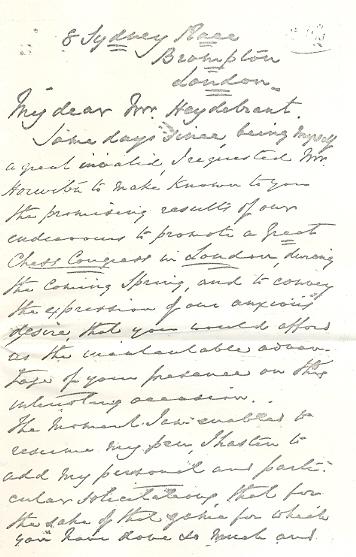
‘8 Sydney Place
Brompton
LondonMy dear Mr Heydebrant,
Some days since, being myself a great invalid, I requested Mr Horwitz to make known to you the promising results of our endeavour to promote a Great Chess Congress in London, during the coming Spring, and to convey the expression of our anxious desire that you would afford us the incalculable advantage of your presence on this interesting occasion.
The moment I am enabled to resume my pen, I hasten to add my personal and particular solicitations, that for the sake of the game for which you have done so much and, I may add, sacrificed so much, you will not suffer any insurmountable impediment to prevent your being present at this striking and unique assemblage – Already from all parts of England, from France, from India & America we have the most gratifying manifestations of sympathy and support, and on all sides there is an anxious longing expressed to learn [hear?] that you will take part in a Congress so fraught with important consequences to the future prosperity of chess.
Do my dear Sir exert yourself to gratify the wishes of the chess community – I wrote to you some weeks ago on [an?] account of our early proceedings through our dear, lost, friend Mr Schumacher, but his illness prevented his communicating with you. In a few days I will send you a programme of the intended assemblage – but, in the meantime, I entreat you to give me the assurance that you will join us. This [That] assurance will induce hundreds to join our standard and infuse the greatest animation through all ranks of players both here and abroad. Should you determine to come, I will later care that you are subjected to conveniences (?) on the score of a residence. London will doubtless be disagreeably full & I have many visitors, but on hearing of the month when you propose coming I will take you comfortable apartments in the neighbourhood of the Town – and on your arrival will meet you in company of Mr Horwitz to convey you from the Railway to my house and from thence to your abode (?).
Anxiously awaiting your reply and with best compliments
I subscribe myself
My dear Sir,
Faithfully yours
H. StauntonHerr Von Heydebrant der Laza
Jany. 20th 1851.’
Page 181 of the 1851 Chess Player’s Chronicle referred to the absence from the tournament of Heydebrand und der Lasa, ‘who, to his deep regret, was unable to leave his diplomatic duties’.
A promising player who died early (in 1929, aged 23) was Ernst Leuppi of Zurich. A brief obituary of this forgotten figure was given on page 47 of the March 1929 Schweizerische Schachzeitung, and the April 1929 issue (page 55) published a game he won against Bogoljubow in a simultaneous exhibition:
Efim Bogoljubow – Ernst Leuppi
Zurich, 1927
Queen’s Pawn, Budapest Defence
1 d4 Nf6 2 c4 e5 3 dxe5 Ng4 4 e4 Nxe5 5 f4 Nec6 6 Nc3 Bc5 7 Nf3 d6 8 Na4 Na6 9 a3 Bg4 10 Be2 Qf6 11 Bd2 O-O 12 e5 dxe5 13 fxe5 Nxe5 14 Nxc5 Nxf3+ 15 Bxf3 Rfe8+ 16 Kf1 Nxc5 17 Bc3 Bxf3 18 Qxf3 Qxf3+ 19 gxf3 Re3 20 Kf2 Rae8 21 Rhd1 Nd3+ 22 Kg3 R8e6 23 Rf1 Rg6+ 24 Kh4 Re2 25 h3 Reg2 26 White resigns.
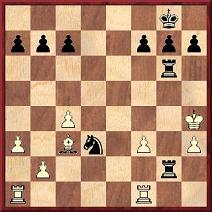
In 1928 Leuppi again faced Bogoljubow, who was playing two other consultation games simultaneously:
Efim Bogoljubow – Ernst Leuppi and Otto Zimmermann
Zurich, 14 January 1928
Two Knights’ Defence
1 e4 e5 2 Nf3 Nc6 3 Bc4 Nf6 4 d4 exd4 5 O-O Nxe4 6 Re1 d5 7 Bxd5 Qxd5 8 Nc3 Qa5 9 Rxe4+ Be6 10 Nxd4 O-O-O 11 Be3 Nxd4 12 Rxd4 Bb4 13 Ne4 Rxd4 14 Qxd4 Rd8 15 Qxg7 Qxa2 16 Rc1 Qd5 17 Ng3 Bd2 18 Rd1
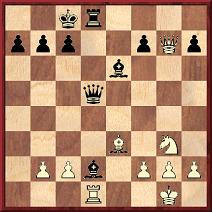
18...Bc3 19 Rxd5 Bxg7 20 Rxd8+ Kxd8 21 c3 a5 22 Ne4 Kd7 23 Nc5+ Kc6 24 Nxe6 fxe6 25 f4 Kd5 26 Kf2 Ke4 27 Ke2 b5 28 g4 a4 29 Bc1 c5 30 h4 b4 31 cxb4 cxb4 32 h5 b3 33 f5 exf5 34 gxf5 Kxf5 35 Kd3 Kg4 36 h6 Bf6 37 Kc4 Bg5 38 Bxg5 Kxg5 39 Kb4 Kxh6 40 Kxa4 Kg5 41 Kxb3 h5 42 White resigns.
Source: Schweizerische Schachzeitung, February 1928, pages 24-25.
The next game, from page 59 of the April 1928 Schweizerische Schachzeitung, was played in the Swiss Championship, in which Leuppi finished equal third:
Ernst Leuppi – E. Müller
Biel, August 1927
Ruy López
1 e4 e5 2 Nf3 Nc6 3 Bb5 a6 4 Ba4 Nf6 5 O-O d6 6 c3 Be7 7 Re1 O-O 8 d3 Bg4 9 h3 Bh5 10 Nbd2 Kh8 11 Nf1 Ng8 12 g4 Bg6 13 Ng3 f6 14 Bb3 Qd7 15 d4 exd4 16 Nxd4 Na5 17 Be6 Qe8 18 Bf5 Bxf5 19 gxf5 Rf7 20 Ne6 Bf8
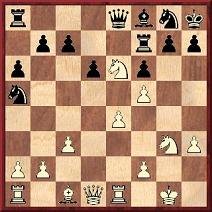
21 Nh5 Nc6 22 Nhf4 Nd8 23 Qh5 g6 24 Nxg6 mate.
In the following year’s Swiss Championship Leuppi finished only ninth but defeated the joint winner in the game below:
Ernst Leuppi – Paul Johner
Basel, April 1928
Nimzo-Indian Defence
1 d4 Nf6 2 c4 e6 3 Nc3 Bb4 4 Qc2 c5 5 dxc5 Na6 6 g3 Nxc5 7 Bg2 d5 8 cxd5 exd5 9 a3 Bxc3+ 10 Qxc3 Ne6 11 Nf3 O-O 12 Nd4 Re8 13 O-O Bd7 14 Be3 Rc8 15 Qb4 b6 16 Rac1 Nc5 17 Rc2 Ba4 18 b3 a5 19 Qc3 Bd7 20 Qb2 h6 21 h3 Qe7 22 Bf4 Nfe4 23 Nf3 Ne6 24 Rxc8 Rxc8 25 Be5 Qc5 26 Nd4 N4g5 27 Nf5 d4 28 Nd6 Qxe5 29 Nxc8 Bxc8
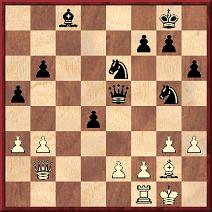
30 Qc1 Qc5 31 f4 Nh7 32 f5 d3+ 33 e3 Nef8 34 Qxc5 bxc5 35 Be4 Ba6 36 Rd1 a4 37 Bxd3 Bxd3 38 Rxd3 axb3 39 Rxb3 Nd7 40 Rb7 Nhf6 41 a4 c4 42 a5 Nc5 43 Rb8+ Kh7 44 Rb4 c3 45 Rc4 Nfd7 46 Rxc3 g6 47 e4 Kg7 48 Rc4 f6
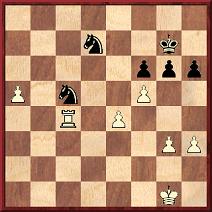
49 Rd4 Nb8 50 Rd8 Nba6 51 Rd6 g5 52 Rc6 h5 53 Kf1 g4 54 hxg4 hxg4 55 Ke2 Kf7 56 Ke3 Kg7 57 Kd4 Nb3+ 58 Kc3 Nbc5 59 Kc4 Nxe4 60 Rxa6 Nxg3 61 Rb6 Resigns.
Source: Schweizerische Schachzeitung, June 1928, pages 93-95.
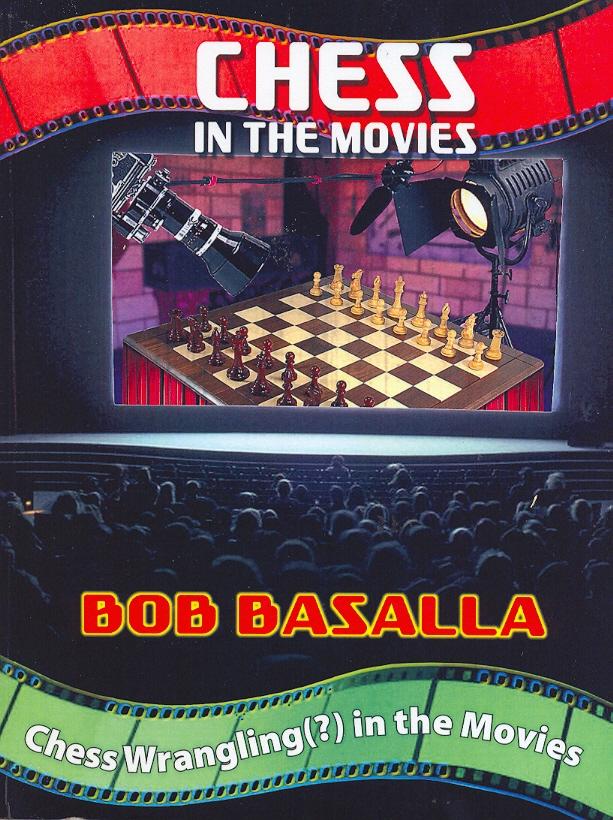
From the outset (i.e. even before the book arrived) we had rather low hopes of liking Chess in the Movies by Bob Basalla (Davenport, 2005), largely because of the dreaded words ‘vanity press’. When, however, the volume turned up, it immediately created a favourable impression as a well-produced 422-page paperback (large-size, in A to Z encyclopaedia format) containing a remarkable amount of fresh information.
Yet as we began to browse, focusing on productions about which we have written, disappointment took the upper hand. C.N. 3858 quoted P.H. Williams (in 1919) on the chess-related poster for The Summer Girls, but the book had no entry for it and there was no way of knowing whether this was an oversight or whether it was only the poster, and not the film itself, which had chess content. Then we looked at the brief entry for the 1987 Cuban/Soviet production Capablanca (pages 61-62). ‘The details I have gathered are sketchy’, writes Basalla, yet the film is readily available in video-cassette format. Nor was it encouraging to read on pages 393-394 that the 1925 Soviet film Chess Fever included documentary footage of Gideon Ståhlberg, who belonged to a later period or, on page 73, concerning the same film, that F.D. Yates was Canadian. Next, we consulted the entry (pages 94-95) for the 1984 Swiss film Dangerous Moves, where Basalla observes that the chess games were ‘created, the credits tell us, by someone named Nicolas Giffard’; whatever may be thought of Giffard’s chess writings, that seems an unattractively disparaging reference to an international master. We turned to the entry (pages 236-238) on The Most Dangerous Match, the chess-related episode of the television series Columbo. In the first paragraph the actor who played the murder victim is misidentified (it was Jack Kruschen, not Lloyd Bochner). Moreover, Basalla appears unaware of the circumstances of the position presented on page 237:
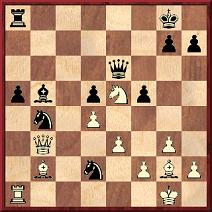
This position was given in C.N. 1557, and in C.N. 1666 Jack O’Keefe pointed out that it came from an actual game: W.J. Wolthuis v C.H.O’D. Alexander, Maastricht, 1946. The finish was 25 Qxb4 Resigns. See pages 3-5 of Kings, Commoners and Knaves.
All this was a poor start for Chess in the Movies, and it was a relief to find on pages 152-153 a good account of the Canadian production The Great Chess Movie (although Basalla really might have been expected to know that the problem attributed to Pope John Paul II is a hoax) and to see the author demonstrating fine critical faculties on pages 293-296 in his detailed discussion of Searching for Bobby Fischer. As we continued, examining other entries for films with which we could claim familiarity, a strange thing happened: the série noire had ended, and Chess in the Movies was growing on us. Basalla’s love of both chess and the cinema is evident, and he has put an extraordinary amount of research into what is, after all, a brave venture, given that no remotely comparable book exists. He states on page 12 that errors are likely in such a large work, and of course they are inevitable in any book of substance. Chess in the Movies, which is available from Amazon, will certainly be scrutinized avidly by readers around the world, and the author invites corrections. We look forward to the prospect of a superb second edition.
There used to be considerable ignorance about the 1925 Soviet film Chess Fever. ‘Did any reader ever see it?’ was the question posed on page 76 of CHESS, 5 December 1959. The same page contained the remark ‘Capablanca’s voice and figure were, we understand, “dubbed in”’, which Stewart Reuben corrected on page 283 of the 18 June 1960 issue by pointing out that the film was made before the advent of sound.
But in what circumstances was the footage of Capablanca included? In the Chess Fever entry on pages 72-74 of Chess in the Movies Bob Basalla writes:
‘“Capa” was actually given “star” billing to goose audience attendance, even though most of his “acting” is just edited in to make him look like a participant. (The technique of Pudovkin’s mentor, Lev Kuleshov, by which unsuspecting people, in this instance the tournament participants and especially World Champ Capablanca, are filmed documentary or news reel style only to have their “parts” spliced into a different movie, a comedy in this case, defines the Kuleshov method.)’
Does contemporary Soviet literature (chess, cinema or general) offer any clarification of what occurred?
Nowadays, Chess Fever is widely available for home viewing.
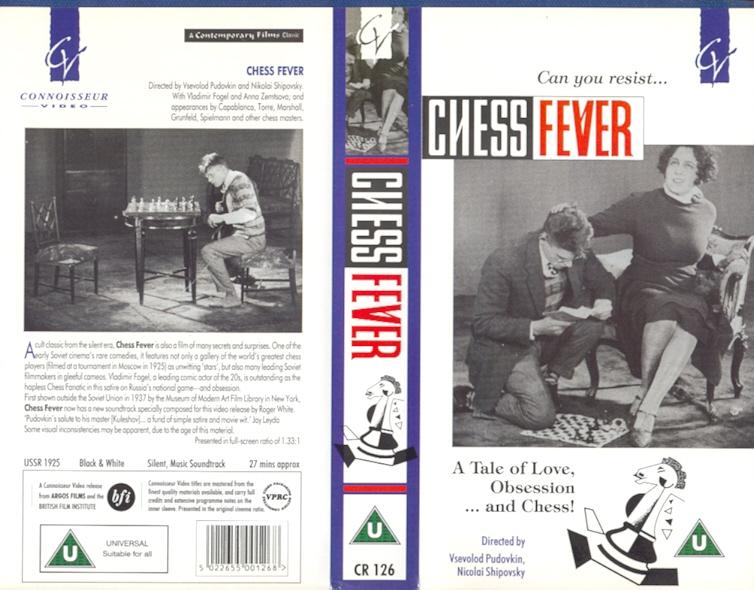
On the subject of the youngest-ever authors of chess books C.N. 543 (see page 108 of Chess Explorations) quoted a contribution from a US correspondent, John Rather, which included the following remark:
‘Pomar’s Mis Cincuenta Partidas con Maestros (1945) and Bobby Fischer’s Games of Chess (1959) were published when their nominal authors were 14 and 15 respectively, but the extent of their involvement in preparing the books is in doubt.’
Now Josep Alió (Tarragona, Spain) writes that Arturo Pomar cannot be regarded as the author of the 1945 book, and he therefore also takes issue with two references written by us in A Chess Omnibus:
Page 114: ‘Source: Mis Cincuenta Partidas con Maestros by A. Pomar (Madrid, 1945), pages 67-71.’
Page 325: ‘There cannot be many autobiographical works in which the birth-date of the subject is not only wrong but also, so to speak, inconceivable. Page 11 of Mis Cincuenta Partidas con Maestros by Arturo Pomar (Madrid, 1945) announced that he was born on 31 September 1931.’
Mr Alió comments:
‘The title-page is rather deceptive, but in reality the book’s author is the well-known Spanish chess writer of the 1940s, Manuel de Agustín, with Pomar referred to in the third person in the text. The correct title is Pomar. Mis cincuenta partidas con maestros.’
Below we reproduce the title page:
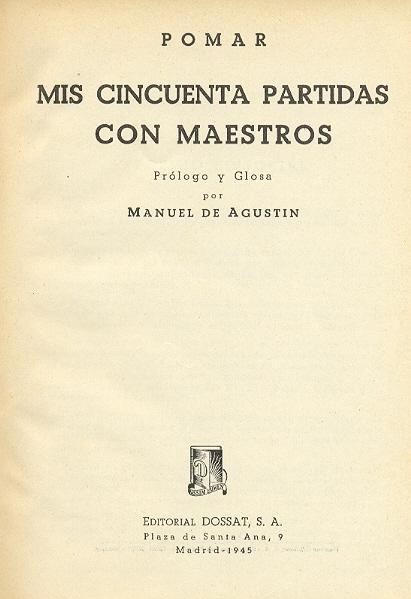
De Agustín was attributed responsibility for the introductory material and the notes. The title means ‘My 50 games with masters’, and authorship was ascribed to Pomar at the time (e.g. in a book list from the publisher on the inside front cover of Ajedrez Español, April 1946). Nonetheless, on the basis of the contents of the book we agree with Mr Alió’s strictures and shall no longer describe it as ‘autobiographical’.
This group photograph from the French Championship in Nice, September 1925 was published on page 179 of L’Echiquier, September 1925:
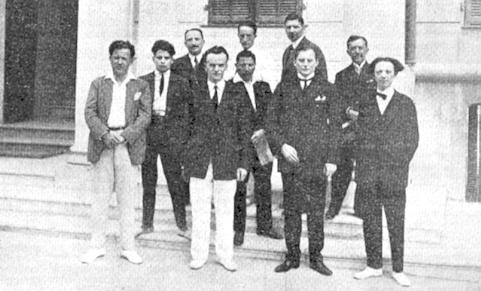
From left to right: A. Chéron, H. Bertrand, F. Lazard, R. Crépeaux, R. Gaudin, M. Duchamp, R. Casier, A. Alekhine, A. Silbert, G. Renaud
From John Donaldson (Berkeley, CA, USA):
‘Page 350A of Volume IV of Jeremy Gaige’s Chess Tournament Crosstables (Philadelphia, 1974) has a crosstable for Warsaw, 1910 (won by Flamberg, with Rubinstein second) and gives as the source “Archives of Daniel J. Greenway”. I have never seen his name elsewhere and wonder if anyone else has. The crosstable for Warsaw, 1910 was a terrific find, apparently not given in any magazines of the time, and it makes one wonder what other discoveries Mr Greenway may have made.’
We plan to scrutinize various items in Wonders and Curiosities of Chess by Irving Chernev (New York, 1974), and the series begins here with a brief one from page 47:
‘On a wager, C.F. Burille solved 62 chess problems in one hour.’
What particulars are available?
Hassan Roger Sadeghi (Lausanne, Switzerland) writes:
‘I very much doubt that what was said about inserting Capablanca in Chess Fever could be true. He interacts with the leading actress in the plot of the film, unlike the other masters, who are indeed merely sitting at their boards.’
This interaction is also mentioned in Bob Basalla’s book Chess in the Movies. As regards the other masters, it may be noted that the set of pairings filmed (e.g. Marshall v Torre and Réti v Yates) corresponds to no round of play at Moscow, 1925, and there is much artificial smiling for the camera. Another point is that the cinema entry in The Encyclopedia of Chess by H. Golombek (London, 1977 and Harmondsworth, 1981) stated that the director, Pudovkin, utilized ‘such real personages as Capablanca and Lasker as figures in his short film’, whereas Basalla writes (justifiably, from our own viewing), ‘I can’t see where Emanuel Lasker appears at all’.
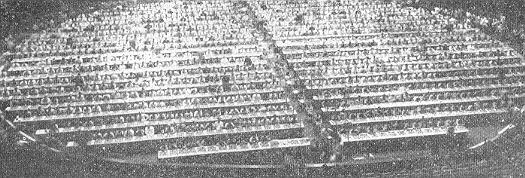
Michael McDowell (Westcliff-on-sea, England) quotes the following from page 16 of A Tribute to G.F. Anderson compiled by G.W. Chandler, C.R. Flood and R.C.O. Matthews (published by the British Chess Problem Society in 1974):
‘The logical element in Kriegspiel problems gives them an appeal to players that many conventional problems lack. Not long after Are There Any? was published, Robert C. Stephenson, one of our members, wrote to Anderson:
“I write because I must have another copy of Are There Any? I had solved only up into the thirties when last night I incautiously carried it down to the Marshall Club to show it to Jack Collins. Then, seeing it in Jack’s hands, Bobby Fischer pounced upon it in great excitement and before the evening was over the two of them had so made it theirs, were so comically oblivious of the mere owner, that I hadn’t the heart to explain that I had brought it to show, not to bestow.”’
Our correspondent comments:
‘Anderson’s 1959 book Are There Any? is a fascinating collection of Kriegspiel problems. I am not aware of any other reference to Fischer showing a direct interest in the composition side of chess (as opposed to Benko setting him problems to solve).’
From page 129 of the April 1930 BCM:
‘A very interesting meeting of the Executive Committee of the British Chess Federation was held in London, on 8 March. Major Sir Richard Barnett, who was in the chair, very kindly offered to purchase and present to the Federation an oil painting of Howard Staunton, dated 1846 ...’
This report was briefly mentioned in C.N. 1136 (see page 193 of Chess Explorations), but no further information about the portrait has come to our attention.

A number of readers replied that the photograph depicted a large simultaneous display during the 1966 Olympiad in Havana, but we had rolled out some tripwire.
It is true, as one correspondent recalled, that a Cuban postage stamp commemorating the Olympiad had a similar illustration:
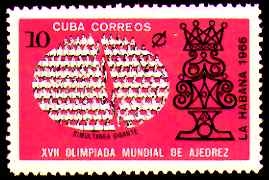
Pages 465 and 466-467 of the Cuban book on the Olympiad, Cuba/66 XVII olimpíada mundial de ajedrez, included two photographs of the ‘simultánea gigante’ in Havana during the team competition:
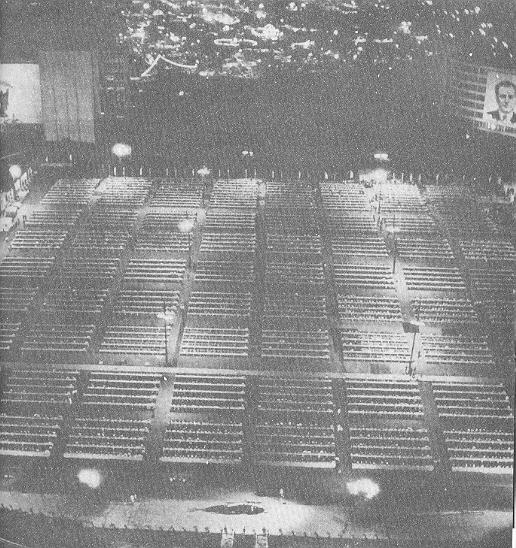
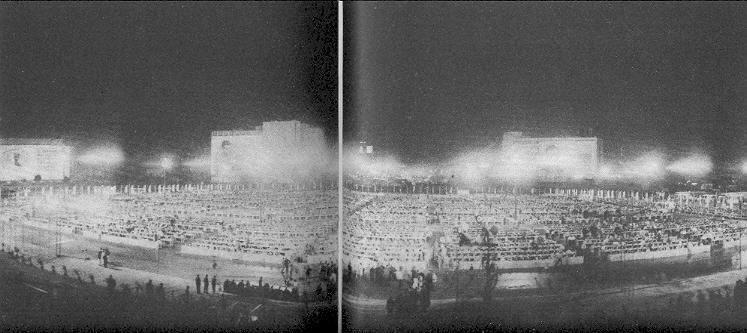
Moreover, the same book (page 40) had, as another correspondent remarked, the picture below, from the fourth Capablanca in Memoriam tournament, i.e. in 1965:
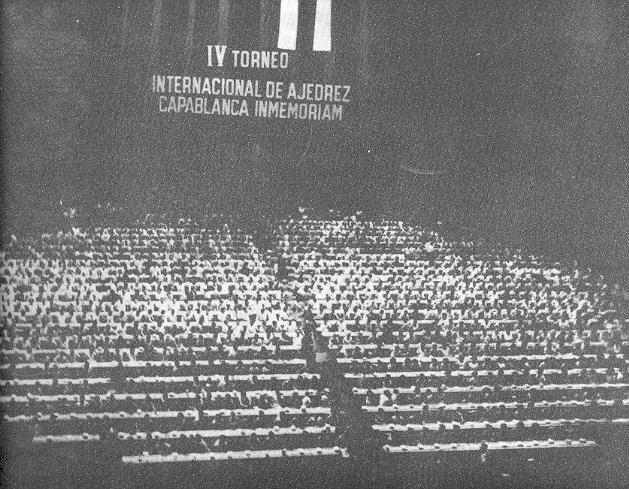
However, the mystery photograph in C.N. 3993 had been published in CHESS two years previously (on page 226 of the 6 May 1963 issue). The caption read:
‘A picture from Havana of the world record simultaneous display on 13 March, in which 40 of Cuba’s leading players, led by the national champion Eleazar Jiménez, tackled one thousand two hundred opponents at the same time.’
This 1963 event was also mentioned on page 41 of the above Cuban book, where the date was given as 12 March and it was stated that 40 masters took on 1,241 opponents.
From page 97 of the Havana, 1966 book mentioned in the previous item comes a photograph of Tigran Petrosian ‘and other masters’ looking at the board used in the 1921 world championship match between Lasker and Capablanca:
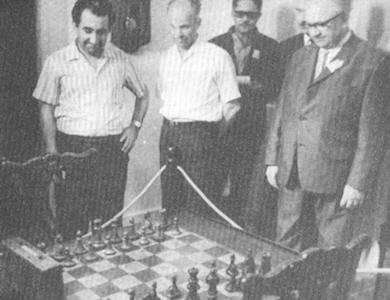
On page 53 of Wonders and Curiosities of Chess (New York, 1974) I. Chernev wrote:
‘L. Hoffer consumed eight hours analyzing a game sent to him for adjudication – which was considerably more than the entire time spent on the game by the players themselves.’
Which was the game?
There was an item ‘Abraham Lincoln as a Chess Player’ on pages 54-55 of “Our Folder”, 1 November 1920 (the publication of the Good Companion Chess Problem Club), presented on the authority of ‘G.M. McConnell, who wrote quite frequently in the Chicago-Times Herald 1897’. Before relating an anecdote, the article stated:
‘Abraham Lincoln was very partial to and quite skillful in the game of chess, and a few years before he was made President Judge Samuel H. Treat, a grave and learned gentleman, then Chief Justice of the Illinois Supreme Court, was his frequent antagonist, and probably a little superior as a player.’
The same issue (page 57) had the following illustration:
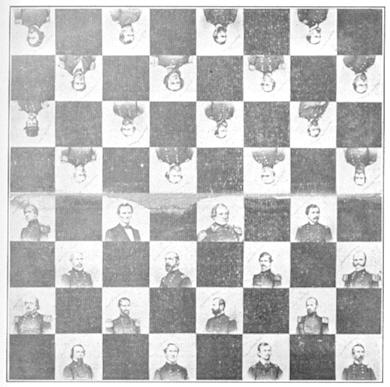
‘A Chess Board decorated with
the portraits of the Generals and Admirals of the Union forces
in the Rebellion.
Pres. A. Lincoln, Commander-in-Chief of the Army and Navy QB4
(c4).
Maj.-Gen. U.S. Grant KR5 (h5).
Patented, 23 September 1862.’
Chess Notes Archives:
| First column | << previous | Archives [15] | next >> | Current column |
Copyright 2005 Edward Winter. All rights reserved.